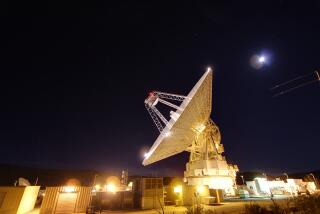The Cutting Edge: COMPUTING / TECHNOLOGY / INNOVATION : R&D; Programs Should Look Into Themselves
A distinguished panel of scientists is quietly waving a huge stick in hopes of encouraging federally funded research programs to come to grips with the reality of todayâs budget limitations. The end of the Cold War, biotechnological breakthroughs, new demands on science brought about by such things as concern over the effects of global warming, and other changes on the technology landscape have left some formerly successful programs trying to justify their continued existence.
The best answer, according to a committee chaired by Frank Press, former director of the National Academy of Science, is for parent agencies to sort out the good from the bad and reallocate resources to the most promising areas, even if that means ending some programs. But shutting down laboratories that have outlived their purpose could be a very hot political potato.
So if the agencies canât do it themselves, the committee has suggested, maybe Congress needs to consider something similar to the base-closing program adopted for the Department of Defense. An independent commission picks which military bases to close and Congress and the president can either close them all or reject the entire list. That reduces the political clout of a single member of Congress who is more concerned about the economic impact on the folks back home than on the importance of a particular facility.
*
Such a program might be necessary for science, Press said.
âWeâre not pushing that as the next step, but eventually it might have to come to this,â he said.
Members of the committee will begin testifying in February before the House subcommittee on science and technology. Their work has already resulted in a report, issued Nov. 29.
Operating under the auspices of the National Academies of Sciences and Engineering and the Institute of Medicine, the blue-ribbon committee was asked to come up with ways of maintaining the nationâs preeminence in science during these days of tight budgets. Like other commissions, Pressâ committee found that the countryâs research program is directed by âan aggregation of agency budgets,â not an overall national strategy--a classic case of the tail wagging the dog.
*
One problem with that approach is that some laboratories outlive their usefulness but continue to function because of political or economic pressures. The committee named no names, but it is clear from the report that many labs could fall into that category.
âThere are some 700 to 900 federal laboratories,â Press said. âThatâs a large number.â But even he was never able to determine the exact number. So many labs are buried in the budgets of various agencies that nobody really knows how many there are or how redundant some of them may be.
The committee recommended that the president develop a comprehensive science policy and then tailor the nationâs research effort to meet those goals. That should force agencies to weed out their weakest programs and transfer funding to those with the greatest prospects.
And if the agencies wonât do it themselves, an independent commission might have to do it for them.
Letâs hope it doesnât come to that. With all the other problems facing scientists in the field these days, trying to justify their existence to an outside body would push their research even further behind the piles of paperwork. But if the scores of federal agencies that have research programs donât move quickly to put their houses in order, that is probably where we are heading.
The statistics offered by the Press committee are a bit grim. The level of federal support for research and development is usually reported at more than $70 billion a year, Press said. But that figure includes things such as building production lines for new weapons systems. When the expenditures are pared back to the kind of basic research that involves the creation of new knowledge or technologies, the correct figure is between $35 and $40 billion, Press said.
That figure is not likely to increase substantially in the foreseeable future, so if America is to maintain its leadership in science, it had better invest its resources in the most promising areas. That will mean cuts for many programs, closing of some laboratories and reallocation of funds from the weak to the strong.
For some, it will be painful. For the rest of us, it is essential.
Otherwise, science in this country is likely to find itself under the threat of a very big stick.
Lee Dye can be reached via e-mail at [email protected].
(BEGIN TEXT OF INFOBOX / INFOGRAPHIC)
Research Spending
Funds spent on research and development--approximately $71.7 billion in 1995--account for a significant portion of the approximately $500-billion discretionary portion of the annual domestic budget not earmarked for entitlements. A look at estimated research and development obligations for government agencies during 1995:
*--*
Amount Agency (in billions) Defense Department $35.2 Department of Health and Human Services 11.6 National Aeronautics and Space Administration 9.2 Energy Department 7.3 National Archives and Records Administration 2.4 Agriculture Department 1.5 Commerce Department 1.3 Transportation Department 0.7 Education Department 0.2 Other 2.3 Total 71.7
*--*
Source: National Science Foundation. Researched by JENNIFER OLDHAM / Los Angeles Times






